The Ultimate Guide to Large Indoor Bird Cages
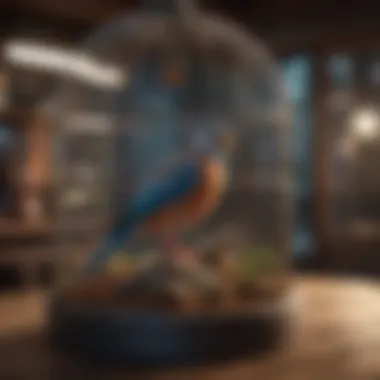
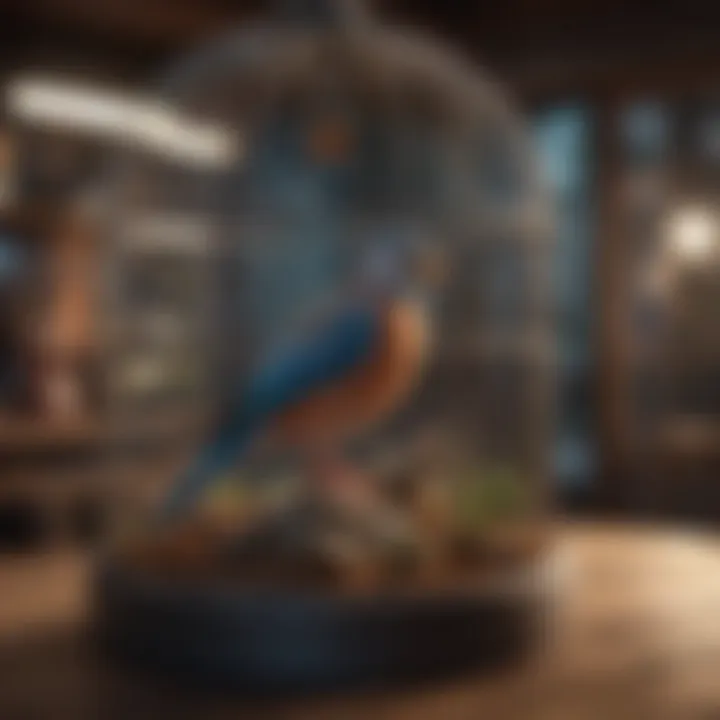
Intro
Creating a cozy and safe environment for pet birds is not just a matter of aesthetics; it’s crucial for their overall well-being. The right large indoor cage can make a world of difference to your feathered friends, allowing room for movement, interaction, and play, while also serving as a sanctuary for rest. With the increasing awareness of bird welfare, it’s time to explore the significant role that these enclosures play in a pet avian's life.
Bird owners might be overwhelmed by the choices available on the market. This guide will dissect not only how to select the right cage but also how to maintain it effectively to enrich the lives of your birds dramatically. Understanding design considerations, selecting materials, and recognizing the behavioral influences imposed by the cage environment are critical components of creating an optimal habitat. With this knowledge, you will be better equipped to provide a nurturing space that promotes both physical health and psychological well-being for your beloved avian companions.
Care Tips
Daily Care Routines
Caring for pet birds involves consistent daily tasks that maintain their environment and happiness. Birds thrive on routine, and establishing a daily care ritual can greatly benefit their mental and emotional health. Here are essential daily activities to keep in mind:
- Feeding: Ensure your birds receive a balanced diet rich in fresh fruits, vegetables, seeds, and pellets. Timing their meals consistently helps them feel secure.
- Social Time: Birds are social creatures, so spend quality time interacting with them every day. This not only strengthens your bond but also keeps them mentally stimulated.
- Observation: Take time to observe your birds. This practice helps you catch any subtle behavior changes that may hint at health issues or stress.
Cage Setup and Maintenance
A well-organized cage setup contributes significantly to your bird's comfort and mental stimulation. Ensure you arrange their space thoughtfully with the following in mind:
- Location of the cage: Position the cage in a place where your birds can have a good view of their surroundings and enjoy natural light without direct sun exposure.
- Perches and toys: Include various perches of different diameters and textures for foot health. Rotate toys regularly to keep the environment exciting and engaging.
- Access areas: Make sure there are areas for food and water that are easily accessible but not so close to the perches that they become soiled quickly.
Hygiene and Cleaning Practices
Keeping your large indoor cage clean is integral to your birds' health. Establish a cleaning routine:
- Daily Waste Removal: Remove droppings and old food remnants every day to prevent bacteria growth.
- Weekly Deep Cleaning: Use bird-safe cleaning solutions, wash perches and toys, and swap out bedding materials at least once a week.
- Monthly Checks: Inspect the cage structure and hardware for any signs of wear and tear, ensuring everything remains safe for your birds.
Seasonal Care Adjustments
Different seasons bring different challenges and opportunities for care:
- Winter: Ensure your home remains at a comfortable temperature and humidity level. Use space heaters cautiously to avoid drafts.
- Summer: Ensure ample ventilation. Avoid placing cages near air conditioning vents, which can create uncomfortable drafts.
- Spring and Autumn: These transitional periods may require increased monitoring for allergens and pests that may affect your bird's health.
Behavioral Insights
Understanding Bird Body Language
Being able to interpret your bird's body language is key to understanding its emotional state. Birds communicate through their posture, vocalizations, and movements. Here are some signs to look for:
- Fluffed Feathers: Indicates your bird might be feeling cold or unwell.
- Head Bobbing: Usually a sign of excitement or contentment.
- Tail Fanning: This can indicate something wrong, like discomfort or fear.
Common Behavioral Issues and Solutions
Birds can sometimes display undesirable behaviors due to various stresses. Identifying the root cause is vital. Here are a few common issues and their potential solutions:
- Feather plucking: Could indicate boredom or stress. Increase mental stimulation with more toys or more time out of the cage.
- Excessive screaming: Often stems from lack of social interaction. Increase your time together or introduce a companion bird as a solution.
Positive Reinforcement Techniques
Training with positive reinforcement is effective and solidifies your bond:
- Use treats to reward desired behaviors.
- Encourage step-up training with gentle persistence and treats for success.
Social Interaction Needs
Socialization is vital for birds as they are inherently social creatures:
- Introduce play dates with other birds (if appropriate) for varied interaction.
- Engage in daily dialogue and mimicry exercises to stimulate your bird cognitively.
Nutrition Guides
Essential Diet Components
A diet of whole foods, including a variety of fruits, vegetables, grains, nuts, and high-quality pellets, is essential. Here’s a basic breakdown:
- Pellets: Should make up about 70% of their diet.
- Fresh Foods: Offer a range of colorful fruits and vegetables daily.
Safe and Toxic Foods
Understanding safe vs toxic items is crucial for pet bird owners. Some safe options include:
- Apples (seeds removed)
- Carrots
- Bell peppers
However, avoid these toxic foods:
- Avocado
- Chocolate
- Caffeine
Supplements and Treats
Occasionally, your pet may benefit from supplements to fill nutritional gaps, particularly during molting or stress. Choose products marked specifically for avian use. Treats should be offered sparingly and can include nuts or seeds.
Feeding Strategies for Different Species
Each bird species has its unique feeding needs:
- Parakeets: Prefer a mix of seeds and pellets with plenty of veggies.
- Cockatiels: Enjoy soft foods and need higher protein during breeding.
Wellness and Health
Routine Health Checkups
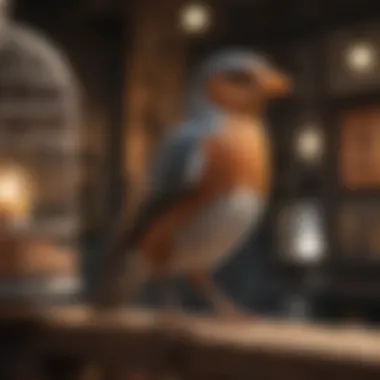
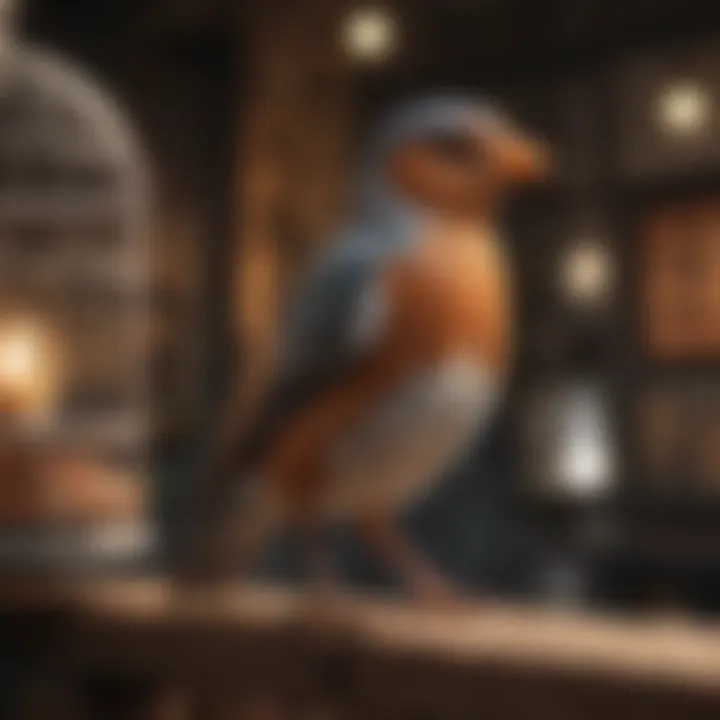
Regular checkups with an avian vet can help catch any potential issues early. Schedule these at least once a year. Regular weight checks at home can also help you monitor health.
Identifying Symptoms of Illness
Familiarize yourself with common signs that indicate your bird may not be well:
- Changes in droppings
- Lethargy
- Loss of appetite
Preventative Care and Vaccinations
Stay proactive in preventing illness by ensuring your birds are up to date on any necessary vaccinations. A well-documented health history will help your veterinarian address issues more efficiently.
Mental and Emotional Well-being
Prioritize mental stimulation by providing interactive toys and social interactions. Boredom can lead to behavioral issues, so keep the environment dynamic and engaging.
Enriching Activities
Toys and Playtime Ideas
Invest in a variety of toys that focus on different skills, like chewing, climbing, and foraging. Rotate toys regularly to maintain your bird's interest.
Training and Tricks
Use positive reinforcement to teach your birds simple tricks. This not only stimulates their minds but also strengthens your bond.
Outdoor Activities and Interaction
On nice days, consider supervised outdoor time in a safe aviary or enclosed space to delight your birds with fresh air and new sights.
DIY Projects for Mental Stimulation
Creating your own foraging toys using common household items helps engage your bird's natural instincts. Think of simple puzzles using paper or cardboard.
Embracing the intricacies of caring for birds not only fosters their well-being but also enriches the lives of their owners. By understanding their needs, we build a bond that stretches beyond simple companionship, leading to rewarding experiences for both parties.
Understanding the Importance of Large Indoor Cages
When it comes to the world of avian companionship, large indoor cages are not just optional havens; they’re essential. For pet birds, especially, having ample space can transform their lives. To understand why these cages matter, we need to dig deeper into what they represent. The significance of large indoor cages transcends mere functionality. They serve as a sanctuary, a versatile habitat, and a dynamic playground that mimics the natural environment.
A Home Within a Home
Imagine your bird settling into a space that feels less like a prison and more like a home within your home. Large indoor cages provide this unique experience — they are like miniature ecosystems where your feathered friends can thrive. Birds are naturally curious creatures. They wander, explore, chew, and interact with their surroundings. A spacious cage offers various levels and compartments, akin to the canopies of their wild habitats.
It's not just the physical size that counts. The aesthetic elements play a role too. Opting for a cage that reflects comfort can positively influence the birds’ mood. Consider integrating natural materials, such as wood perches and real branches, in addition to the cage itself. It creates a familiar ambiance, easing their transition from the wild to the domesticated space.
Benefits for Pet Birds
The advantages of large indoor cages are plentiful, and each benefit plays a part in promoting the overall well-being of pet birds:
- Physical Health: Bigger spaces allow for increased movement. Birds need to fly, stretch, and engage in physical activities to avoid health ailments. With sufficient room, they can exercise freely, which maintains muscle tone and strengthens cardiovascular health.
- Mental Stimulation: Imagine living with walls that close in on you; that's how birds feel in cramped cages. Large indoor cages provide various toys, perches, and entertainment options that help keep their minds sharp. This stimulation can prevent boredom, unnecessary frustration, and stop unwanted behaviors from developing.
- Socialization Opportunities: Birds are social animals. A large cage allows for multi-bird setups, where they can interact harmoniously or, at times, retreat to personal spaces. This balance is vital for their emotional well-being. Even if you have one bird, a larger enclosure allows for interaction with humans and other pets without feeling constrained.
- Stress Reduction: A significant factor often overlooked among bird keepers is stress. Larger cages make birds feel safer, offering them room to fly away or perch above when feeling threatened. Addressing their natural instincts leads to much calmer and happier birds.
Types of Large Indoor Cages
When it comes to providing a suitable environment for pet birds, the type of cage can make all the difference. Large indoor cages not only serve as a home but also support the physical and mental well-being of avian companions. In this section, we will dissect the varieties of large cages available and discuss their unique benefits and considerations, allowing pet owners to make informed choices.
Walk-in Cages
Walk-in cages represent the pinnacle of spaciousness for pet birds. These structures are typically larger than standard cages, offering ample room for birds to move freely and engage in natural behaviors. Common in shelters or dedicated avian spaces, walk-in cages allow for an incredible level of interaction not just between birds but also with their human caregivers.
- Encourages Exercise: With enough space to fly and perch, birds can burn off excess energy and maintain a healthy weight.
- Social Opportunities: If well-structured, these enclosures can accommodate multiple birds, promoting social interaction that is essential for many species.
- Versatile Designs: Owners can create a mini aviary within their homes, using plants, branches, and other elements to simulate a bird's natural habitat.
However, walk-in cages do have drawbacks. They require ample floor space and may not be suitable for all households. They can be an investment in both time and money.
Multi-Level Cages
Multi-level cages are a great choice for pet enthusiasts who don’t have the luxury of extreme space but still want to provide their birds with opportunities to explore. These cages consist of multiple levels connected by ramps and perches.
- Space Efficiency: This design makes the most of vertical space, freeing up floor area while still providing an expansive environment for exploration.
- Behavioral Benefits: Birds enjoy climbing and exploring, which can reduce boredom and promote physical activities that are crucial for their well-being.
- Customization: Various levels can be tailored for different activities, such as sleeping, eating, or playing, which encourages healthy habits.
Nonetheless, bird owners should ensure that the space between levels is appropriate for the species. Some birds may struggle with steep ramps or small perches, possibly leading to frustration.
Customized Cages
Customized cages are a flexible solution for those looking to create a truly unique environment tailored to the specific needs of their pets. They can be designed in various shapes, sizes, and materials, often accommodating unique features that off-the-shelf options lack.
- Personalized Design: Owners can specify dimensions, colors, and features like built-in feeding stations, special perches, or hideaways.
- Species-Specific Needs: Customization allows for addressing the unique needs of different bird species, ensuring that different sizes or types of perches and toys are available.
- Enhanced Comfort: By including items that mimic natural habitats or allow ease of access to food and water, customized cages can lead to enriched living environments for birds.
However, creating a custom cage can be resource-intensive. It takes careful planning and budget consideration, and the results may vary depending on the execution of the vision.
"The choice of cage significantly influences the quality of life for pet birds, whether they belong to a tight-knit flock or are cherished companions."
In choosing the right type of large indoor cage, pet bird owners must weigh these options against their individual needs and circumstances. A thoughtful approach can lead to a well-rounded habitat that promotes not only physical health but also a content and engaged avian community.
Key Features to Consider
When diving into the world of large indoor cages for birds, it’s easy to get lost in the specifics. However, knowing what to focus on helps create a more livable and enjoyable environment for your feathered friends. These key features should be looked at as the backbone of the housing framework. Leaving any of these aspects to chance wil only lead to a frustrating experience for both the birds and the owner.
Size and Space Requirements
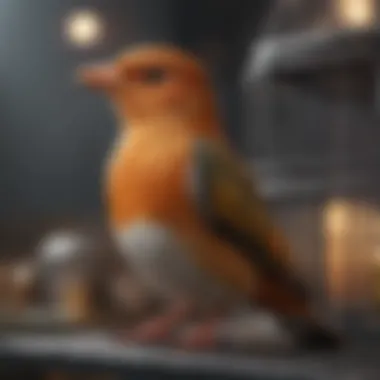
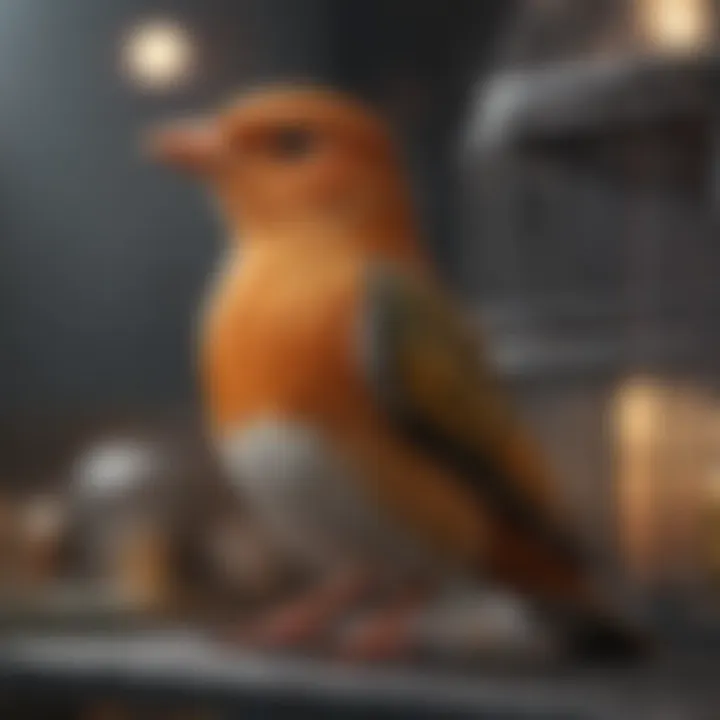
Choosing the right size of a cage isn't just about having enough room for those adorable little chirpers; it's about providing them with their own territory. A spacious environment allows for flying, exercising, and, let’s be honest, just being inherently bird-like. A small cage can lead to a host of behavioral issues, including stress and aggression. Ideally, the length, width, and height should feel like a comfort zone for your birds, allowing them to flap their wings without knocking over their favorite toys.
Generally speaking, the larger the cage, the better. As a rule of thumb, if you have a budgie or a parakeet, a cage with a minimum width of 18 inches should be your starting point, whereas cockatoos and larger parrots might need a cage size nearing 4 feet in width! This isn’t just personal preference; birds thrive in spacious settings.
Materials and Durability
The materials making up a cage play a vital role in not only ensuring longevity but also in guaranteeing the safety of your beloved avian companions. Opting for powder-coated metal cages is smart. These materials endure the wear and tear that comes from active birds pecking and climbing. Steer clear of wooden cages, as these can harbor harmful bacteria and may not be the best choice for longer-term use.
It’s equally important to consider any coatings or finishes. Avoid cages with toxic finishes that could harm your pet. Checking for a certification indicating it's free from harmful substances will bolster your peace of mind.
Accessibility for Maintenance
Cages that might be tricky to clean can turn pet ownership into an uphill battle. Look for designs that allow for easy access—think sliding trays and removable perches. A cage that makes daily cleaning a breeze is a gift that keeps on giving. Regular maintenance not only keeps the cage visually pleasing but also ensures birds remain healthy and disease-free.
Also, consider your personal convenience. If a cage is a chore to maintain, it might skew your whole experience of being a pet owner. Having easy access to every nook and cranny should be a priority.
Safety Considerations
Last but hardly least, safety can’t be relegated to the back burner. Birds are curious creatures and will explore anything within reach, which sometimes includes chewing on items that may be harmful. Look for features such as rounded edges, secure latches, and none of those tiny bars that could ensnare little toes. Regular inspections to check for wear-and-tear also ensure their environments stay secure.
"Safety first! Your happy bird is worth every ounce of effort you put into creating their sanctuary."
Additionally, remember to evaluate where the cage will sit within your home. Keeping it away from potential hazards—like an open terrace or drafty windows—solidifies your commitment to their safety and well-being. Each factor plays a part in building a cage that will suit both the birds' instincts and the owner's peace of mind.
Cage Placement and Environment
Selecting the right cage for a pet bird goes beyond simply choosing the model or size. The placement and surrounding environment of the cage play a critical role in ensuring the bird's well-being. Just like a comfy chair in a cozy room makes for a pleasant evening, a thoughtfully placed birdcage adds real comfort to avian life. Below are some key considerations:
Optimal Room Conditions
When thinking about where to put a bird's cage, one must consider optimal room conditions. The area should be free from drafts and extreme temperatures. Birds are sensitive creatures and can easily fall ill if they are subjected to sudden shifts in temperature or chilly breezes. Ideally, a room that maintains a steady temperature between 65 and 75 degrees Fahrenheit is best for most pet birds.
Also, safety is paramount. Keep the cage away from potential hazards like open windows, ceiling fans, and other pets that might pose a threat. A corner of a room can work well, offering a sense of security because it feels enclosed. However, ensure that the cage still allows for enough visibility, as social creatures like birds can easily get depressed when isolated. Additionally, it's worth noting that noise can greatly influence your bird's mood; a quieter area away from loud televisions or boisterous family activities is more conducive for relaxation.
Natural Light and Airflow
Next up is the need for natural light and airflow. Birds thrive on sunlight, which is not just beneficial for their mood but also aids in vitamin D synthesis. However, it's essential to balance this with protection from excessive heat or direct sunlight, especially during peak hours. Placing the cage near a window could be good, but consider using sheer curtains to filter the light. This way, your birds can bask in uplifting rays without frying, just like you'd use sunscreen on a sunny day.
Having a good airflow is also vital. Stale air isn't just uncomfortable; it can lead to respiratory issues in birds. Ensure that the area where you place the cage allows for natural ventilation, which keeps the air fresh. Installing a small fan (preferably on a low setting) nearby can also help; however, make sure it isn’t blowing directly into the cage, as birds can find that disconcerting.
Social Interactions
Lastly, social interactions hold great importance in a bird's complete environment. Birds are social beings, and their happiness often relies on the companionship they experience. Positioning the cage in a common area of the house, where the family gathers, can help your feathered friend feel more included. If you've ever seen a parrot respond positively to its owner’s voice or gestures, you know how much they thrive on interaction.
However, while it's beneficial to have them close, be mindful of the potential for overstimulation. This can happen if there are too many loud noises or chaotic activities happening around them. Finding a middle ground is key; the cage should be in a sociable yet calm area, so the bird feels included but not overwhelmed. Additionally, rotating their toys and engaging with them regularly can nurture their social needs, fostering a more enriching environment.
"In the realm of avian care, placement is as crucial as the cage itself. It's about cultivating an atmosphere that reflects love, safety, and engagement."
By paying careful attention to their cage placement and environment, you're not just creating a home for your birds; you're enriching their lives. This sets the foundation for their happiness and health, making your role as a bird owner not just practical but meaningful.
Enrichment and Customization Options
When we speak about large indoor cages, one mustn't overlook the importance of enrichment and customization. Birds are not mere pets; they are intelligent creatures with needs that must be met to allow them to flourish. The choices you make in terms of enhancing their environment can significantly boost their happiness and overall health. Providing the right elements means creating a space where they feel secure and stimulated.
Toys and Perches
Toys and perches are essential components in any avian habitat. They serve multiple roles: engaging a bird’s curiosity while promoting physical and mental health. A variety of toys can be scattered about to keep things interesting. Look for options that encourage chewing, climbing, and problem-solving. Wooden blocks, ropes, and bells can bring a dynamic aspect to your bird's playtime.
It's also critical to consider the variety of perches. Birds need different textures and sizes to maintain foot health. Natural branches, rope perches, and platform perches can provide essential variety. Different heights within the cage will create an opportunity for your bird to explore their space vertically, which is especially beneficial for species known for their climbing tendencies, like parakeets and cockatiels.
Feeding Stations and Water Sources
An effective feeding station is one of the pillars of any healthy bird habitat. Ensure that food is easily accessible at all times, as birds can be picky eaters. Use shallow dishes that minimize mess but provide enough space for your bird to partake comfortably. Placing food in different locations can also mimic foraging behavior, promoting natural instincts.
Water is just as paramount. Having a clean water source is vital. Automatic waterers can be a practical solution for those who may forget to change the water daily. It not only keeps water fresh but also reduces spills, which helps maintain cleanliness in the cage.
Hideaways and Play Areas
Creating hideaways and distinct play areas within a large cage can enhance your bird's sense of security. Birds naturally seek refuge, and providing them with nooks like igloo-shaped huts or tunnels encourages relaxation. They can retreat and feel safer when feeling threatened. Don’t underestimate how often a simple cardboard box cut into a hideaway can serve the purpose.
In addition to hideaways, established play areas are a must. Designating specific spots for climbing structures, swings, and ladders can turn the cage into a vibrant play zone. Offering features such as hammocks or hanging toys takes it up a notch and gives room for birds to navigate their space joyfully.
"An enriching environment is not just a luxury for your birds; it's a necessity that mirrors their natural habitat."
By thoughtfully exploring these customization options, bird owners can transform a standard cage into a thriving environment where their avian companions can explore, play, and relax. Keeping things fresh with periodic changes in toys, perches, and arrangement aids in maintaining a stimulating atmosphere, addressing both physical and psychological aspects of avian life.
Maintaining Large Indoor Cages
Maintaining large indoor cages is not just about keeping a tidy space; it's an essential aspect of responsible bird ownership. Proper maintenance directly affects the health and well-being of your avian companions. A clean and well-maintained cage not only promotes hygiene but also reduces stress for the birds, leading to happier and more active pets. By staying on top of routine cleaning, pest management, and regular inspections, you can help ensure your feathered friends thrive in a safe environment.
Routine Cleaning Practices
Cleaning the cage should be a part of your daily, weekly, and monthly routines. Simple tasks, like removing uneaten food and changing water, should be done daily. It's the little things that, if neglected, can quickly pile up. Here’s a simple roadmap:
- Daily Tasks: Remove leftover food, refresh the water, and spot-clean any mess on the perches or bottom of the cage.
- Weekly Chores: Take everything out of the cage, including perches and toys. Give them a wash with bird-safe soap, and scrub the cage thoroughly with a non-toxic cleaner. Rinse well to ensure no residue is left.
- Monthly Inspections: Once a month, perform a deep cleaning. Disassemble the cage if possible and give it a thorough wash. This is the time to check for any signs of wear and tear.
An important tip: Always ensure that any cleaning products used are bird-safe. Chemicals found in some household cleaners can be toxic to birds and should be avoided at all costs.
Preventing Pests and Illness
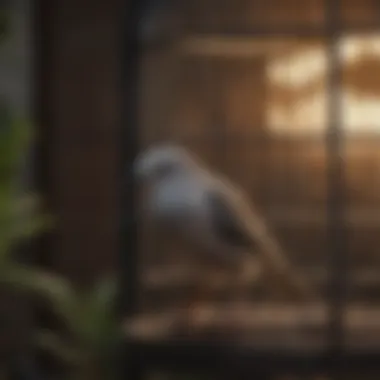
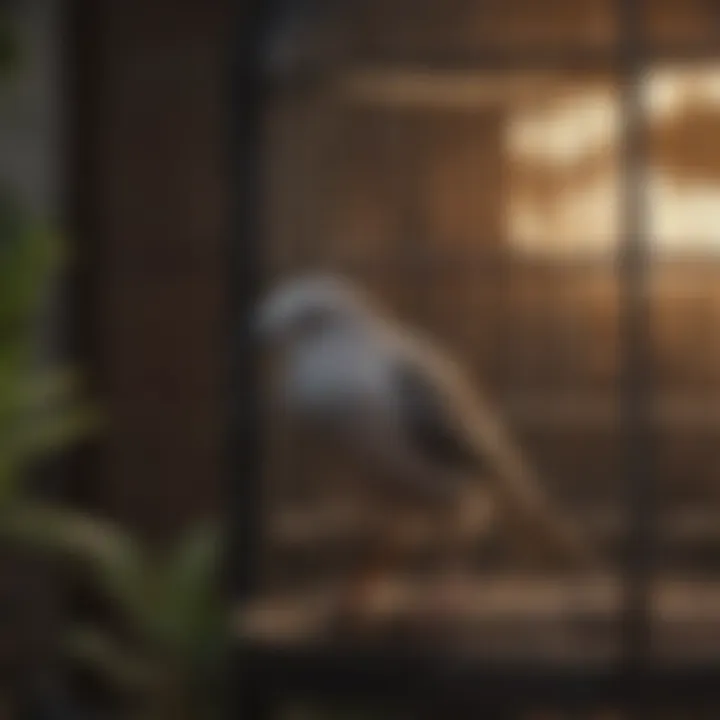
An often-overlooked aspect of cage maintenance is pest prevention. Just like any living area, cages can attract pests if not properly maintained. Here are some effective strategies:
- Food Control: Keeping the cage clean, particularly around feeding areas, greatly reduces the chances of pests taking up residence. Store bird food in airtight containers and avoid overfilling bowls.
- Inspection for Signs of Infestation: Regularly check for signs of insects, rodents, or mold. Catching these issues early is key.
- Hygiene Practices: Maintaining a clean environment is the first line of defense against bird illnesses. Regularly wash your hands before and after handling your birds to avoid transferring pathogens.
- Quarantine New Birds: If you introduce a new bird into your home, isolate it for a while to ensure it doesn’t carry diseases that could infect your existing pets.
Establishing these practices not only protects the pets but also provides peace of mind for the bird owners.
Inspection and Repairs
Regular inspections of the cage are critical for the safety of your birds. A thorough inspection should include:
- Checking for Damage: Look for rust on metal components, weak areas in the structure, or places where the birds could escape or get stuck. A small issue can quickly snowball into a larger problem if ignored.
- Tightening and Securing: Fasten any loose screws, tighten bolts, and ensure everything stays secure. A well-maintained cage is a safe cage.
- Replacing Worn Items: Any perches, toys, or accessories showing signs of wear and tear should be replaced right away to prevent injury.
By taking these proactive measures, you can avoid many headaches down the line and keep your feathered companions safe and sound.
"Consistent maintenance not only safeguards the health of the birds but also enhances their quality of life. A well-cared-for environment reflects your commitment as a bird owner."
With steadfast attention to these maintenance practices, you're not just providing a cage; you’re creating a sanctuary for your avian friends, fostering their health and happiness for years to come.
Behavioral Observations in Large Cages
Understanding bird behavior is crucial when it comes to creating an enriching environment within large indoor cages. The way pet birds interact with each other and their surroundings can give insights into their well-being. By focusing on behavioral observations, owners can better cater to their birds' needs, ensuring they lead happy and healthy lives. Observing these behaviors also helps in identifying issues early on, promoting preventive care in an avian setting.
Social Dynamics Among Birds
In large indoor cages, the social interactions between birds become a vital observation point. Just like humans, birds have their own social structures and hierarchies. When multiple birds share a space, you might see certain dominant birds establishing themselves while others take a more submissive role. Often, this is reflected in their feeding practices, perch preferences, and even playtime activities.
For instance, when setting up the cage, it’s wise to introduce various perches and spaces where some birds can retreat if they feel overwhelmed. This helps in balancing interactions. A well-structured environment can reduce conflicts and establish harmony among avian residents. Understanding these social nuances can not only prevent fights but also foster companionship that can enrich their lives. Thus, monitoring their interactions helps to assess factors such as compatibility and overall happiness in their shared habitat.
Exploration and Activity Levels
Birds are naturally curious creatures. In a spacious indoor cage, they often exhibit a range of exploratory behaviors. These behaviors include climbing, flapping, and sometimes even acrobatics that indicate their comfort level within their environment. Active birds tend to be healthier, both physically and mentally.
To encourage these explorative tendencies, one can integrate various toys, hideouts, and even natural elements like branches to climb on. Not all birds will respond the same way; some may spend a lot of time exploring, while others may prefer a more static lifestyle. By keeping an eye on their activity levels, owners can gauge whether their birds have enough stimuli to keep them engaged or if they are showing signs of boredom.
Moreover, regular activity promotes physical exercise, helping to maintain their feather quality and overall health. Thus, it’s essential to provide ample opportunities for exploration as it plays a key role in their general demeanor.
Stress Indicators and Solutions
While large indoor cages can offer numerous benefits, they can also become stressful environments if not properly managed. It’s crucial for bird owners to recognize the signs of stress among their pets. Common indicators include excessive screeching, pacing, or feather plucking. These behaviors may signal that a bird feels cramped or threatened even in a seemingly spacious cage.
To alleviate stress, providing adequate hiding spots can be essential. Birds need spaces to retreat and feel safe, especially during times of loud noises or sudden movements. Additionally, keeping social dynamics in check, as discussed earlier, helps prevent bullying or turf wars among bird inhabitants.
In essence, regular monitoring of these behavioral indicators, combined with immediate action to enforce their comfort, can significantly enhance their day-to-day experience within large indoor cages. Bird owners should be proactive in addressing these behaviors to maintain a harmonious and loving cage environment for their feathered friends.
"A bird's behavior can tell you more about its health than any vet visit."
Common Mistakes and Misconceptions
Understanding common mistakes and misconceptions about large indoor cages is crucial for any bird owner. These missteps can significantly impact the well-being of avian companions, affecting everything from their health to their overall happiness. Addressing these issues will aid bird owners in fostering the most positive environment for their pets. Awareness leads to better practices, and this section aims to clarify misunderstandings to promote optimal care.
Overcrowding Issues
One of the prevalent mistakes made by bird owners is overcrowding. Many assume that since their feathered friends enjoy company, they can fit multiple birds in a single cage without adverse effects. This, however, is a flawed perspective. Each bird requires personal space to feel secure and comfortable. Overcrowding can lead to aggressive behaviors, stress, and conflict among the occupants. Bird owners should evaluate the species and size of their birds when considering cage capacity.
- Understand Species Needs: Different bird species have varying social structures. For example, finches may appreciate a communal space more than a solitary cockatoo.
- Monitor Behavior: If you notice signs of aggression, such as chasing or territorial disputes, it might be time to rethink the cage arrangement.
- Consider Individual Space: Follow the guideline of providing at least two square feet for each small bird and more for larger species.
Creating a harmonious living space should be the priority, ensuring all birds coexist safely and happily.
Misunderstanding Bird Needs
Many new bird owners harbor misconceptions about what their birds truly need for a fulfilling life. It's common for individuals to assume that simply providing food and water is sufficient. However, there’s much more to consider when it comes to a bird’s emotional and physical health.
- Diverse Diet: A balanced diet is as vital as a comfortable cage. Birds thrive on a mixture of seeds, fresh fruits, vegetables, and specialized bird pellets. Ignoring this can lead to malnutrition and serious health issues.
- Social Interaction: Birds are social creatures by nature. Lack of interaction with their owners or other birds can result in loneliness and stress, manifesting in destructive behaviors. It’s recommended to spend time with them daily and to consider having more than one bird for socialization, if feasible.
- Environmental Enrichment: Birds require more than just space to move; they need stimulation. Toys, climbing structures, and changing the layout of their cage regularly can keep boredom at bay, allowing them to express natural behaviors.
When bird owners truly understand the diverse needs of their pets, they set the stage for a lifetime relationship filled with joy and companionship.
Ignoring Cage Location
Another common mistake is neglecting the importance of cage location in a home. It’s not enough to just place the cage anywhere; the environment around the cage plays a crucial role in a bird’s well-being.
- Avoid Drafts and Direct Sunlight: Birds are sensitive to extreme temperature changes. Locate their cage away from air conditioning vents, heating sources, and direct sunlight to ensure their comfort.
- Social Situations: Birds thrive on interaction. A cage tucked away in a seldom-used room can lead to feelings of isolation. Positioning the cage in a busy area of the home allows birds to feel included in family activities.
- Noise Levels: Consider the noise levels of the chosen location. Tuck the cage away from loud appliances or music systems that could disturb their peace, potentially causing stress.
By selecting an optimal location, owners can ensure that their birds feel secure and engaged within their environment, fostering a happier and healthier life.
"The space in which a bird lives plays a significant role in its happiness and well-being. Find a balance between stimulation and comfort."
In summation, being mindful of these common pitfalls can make a monumental difference in the quality of life experienced by pet birds. Ensuring proper care not only supports their well-being but also fortifies the bond between pet and owner.
Culmination: The Role of Space in Avian Care
Understanding the significance of adequate space for pet birds cannot be overstated. As we wrap up our journey through the realm of large indoor cages, it's clear that these enclosures serve as more than just habitats; they are vital for the overall health and happiness of our avian friends. When we provide a spacious environment, we aren’t just showing affection, we're catering to their psychological needs. Space promotes physical activity, which is crucial for maintaining a healthy weight and reducing the risk of illnesses linked to inactivity. Furthermore, a well-designed large cage responds to a bird's instinctual behaviors, such as hopping, flying short distances, and interacting freely with toys or fellow companions.
Moreover, the spacing in a cage influences social dynamics, enabling birds to establish their own territories and hierarchies when kept in groups. This will not only prevent conflicts but also promote a sense of security among the birds. The right amount of space is intrinsic to allowing them to display their natural behaviors, which directly contributes to their overall well-being.
A spacious cage contributes significantly to mental stimulation. When birds have room to move, explore, and play, they're less likely to develop behavioral problems caused by boredom or confinement.
This brings about the much-needed conclusion I believe we all can agree upon – large indoor cages play an essential role in avian care, offering both physical and psychological nourishment.
Summary of Key Points
- Space is critical for physical activity: Birds require room to engage in natural movements, which is vital for their physical health.
- Behavioral expression: A spacious living environment enables birds to exhibit instinctual behaviors, reducing stress and improving overall happiness.
- Social hierarchies: For those who keep multiple birds, adequate space prevents territorial disputes and allows birds to feel secure.
- Mental stimulation: Ample space encourages exploration and play, contributing to better mental health in birds.
Future Considerations for Bird Owners
As pet bird owners, it’s vital to keep evolving our understanding of how space affects avian well-being. Here are some future considerations for enhancing the lives of our feathered companions:
- Reevaluate existing setups: Periodically assess whether the cage size is still suitable as a bird grows or if circumstances change. More space may become necessary.
- Innovative designs: Stay informed about new trends in cage designs that prioritize space, functionality, and creativity for bird care.
- Community Engagement: Engage with fellow bird enthusiasts via platforms like reddit.com or facebook.com to exchange ideas, experiences, and tips related to cage setups.
- Post-setup evaluation: After upgrading or changing a cage, observe how the birds interact with their new environment. Are they utilizing the space as intended?















